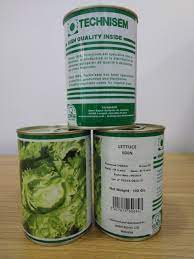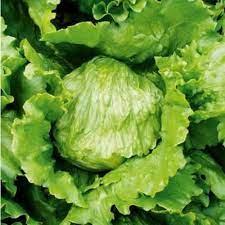No products in the cart.
Return To Shop
0
₦0.00
0
Shopping cart (0)
Subtotal: ₦0.00
Spend ₦500.00 to get free shipping Congratulations! You've got free shipping.
Log in / Sign up
Login Register
Detroit Dark Red Beetroot Seed...
₦3,500.00


Ganga Sweet Pepper Seeds (East...
₦6,499.00
Eden Lettuce Seeds (Technisem Seeds)
₦5,000.00
Eden Lettuce Seeds
Craving crisp, homegrown lettuce all year? Look no further than Eden Lettuce Seeds from Technisem! This heat-resistant iceberg variety thrives in hot and humid climates, boasting large, compact heads with a long shelf life. Enjoy delicious salads, sandwiches, and more, season after season!
Eden Lettuce from Technisem may be cultivated all year. Local sprinkling irrigation during the dry season improves crop success.
benefits of Eden Lettuce Seeds:
- Year-round harvest: Enjoy fresh lettuce not just in spring and fall, but throughout the summer and even into winter! Eden’s adaptability makes it a season-extender for your garden.
- High yields: A single packet of seeds can yield thousands of plants, providing ample lettuce for your family and friends.
- Easy to grow: iceberg lettuce seeds is a reliable performer, even for beginner gardeners. Its fast maturity (ready in just 50 days) and disease resistance make it a hassle-free choice.
- Nutrient powerhouse: Packed with vitamins A, C, and K, Eden Lettuce is a nutritious addition to any diet.
21 people are viewing this product right now
Please, activate Compare option to use this widget.
SKU: eden-lettuce-seeds-technisem-seeds Categories: Seeds & Seedlings Tags: Eden, Lettuce, Seeds, Technisem
Estimated delivery:4 days
Share:
Eden Lettuce Seeds
This Iceberg type yields some good, large, and compact lettuce that is heat-tolerant and has a lengthy shelf life after harvest. Even in a hot, humid tropical environment, Eden Lettuce from Technisem may be cultivated all year. Local sprinkling irrigation during the dry season improves crop success.
Characteristics of Eden Lettuce Seeds
Diverse: Eden
Net 100g and 10g in weight
50 days till maturity
Seed Amount required per acre: 160–240 grams of plants, or 32000–48000
fundamental traits of variety: large, heat-resistant, and long-lasting dark green heads.
This Iceberg type yields some good, large, and compact lettuce that is heat-tolerant and has a lengthy shelf life after harvest.
Heart: quite large and weighty
Color: brilliant green
Weight range: 600 to 700 grams
Leaves: Well-divided and blistered
50 days after transplanting is considered to be precocious (depending on the crop’s location and the climate).
Benefits to the health of Eden Lettuce: Resistance
Bone Strength: Vitamin K has a high percentage, therefore consuming enough of it can lower your risk of suffering a bone fracture which helps strengthen bones in Lettuce.
Water makes up more than 95% of raw lettuce. Eating lettuce moisturizes the body as a result. Although drinking liquids is essential, eating foods that contain water can also considerably help one stay hydrated.
Better Vision: Lettuce includes vitamin A, which is important for eye health and so enhances vision. The risk of cataracts can be decreased by vitamin A. Additionally, vitamin A protects against macular aging.
Sleep: It has also been demonstrated that extracts of many lettuce varieties might improve sleep. It is unknown if the lettuce in its natural state can have a comparable impact until more research is done. Due to the sedative properties of lettuce, it aids in sleep induction.
Nutrition: Different lettuce types have different nutritional values. A large amount of vitamin A, along with trace levels of vitamin C and iron, are present in almost all lettuces.
Growing Eden Lettuce: A Guide
A simple to cultivate annual vegetable is lettuce. When the temperature ranges from 60 to 70 degrees F, lettuce, which is regarded as a spring and fall crop, thrives. Numerous types can be harvested as microgreens much earlier and several cultivars mature in as little as 30 days. These easy methods will provide you with a plentiful supply of crisp salad greens all year long, from your garden beds to patio pots.
What Season to Plant Lettuce
Lettuce enjoys chilly temperatures. Once the soil can be worked in the spring, you can start planting leaf, romaine, and butterhead lettuce.
The temperature range in which lettuce germinates varies from 40 to 85 degrees Fahrenheit. You’ll get a longer crop if you grow lettuce in successive plantings with 10 to 14 days between them. One month before the onset of the warm summer months, halt planting to avoid summer bolts. So that it matures in time for the cool fall weather, start planting fall lettuce in the late summer.
After the last date of frost in the spring, head lettuce is often started indoors or in a cold frame and then transplanted. A nice approach to start the growing season early is to cultivate lettuce from seedlings for early spring transplant.
Where to plant lettuce
In a region that gets full sun, lettuce grows best in the spring and fall. Partial shade can offer relief from the heat if you intend to produce lettuce in the summer or in warm planting zones. The soil needs to be kept cool for germination when growing lettuce from seed in the late summer. When the weather becomes cooler, the shade can be taken down so that young lettuce plants can receive plenty of sunlight.
In loose, cold soil with sufficient drainage, lettuce grows best. Organic resources, such as compost or manure, will improve your lettuce growth environment by improving drainage and supplying vital nutrients. Consider buying a soil test kit if you’ve experienced issues with lettuce growth.
Low pH is harmful to lettuce. Lime can be added to the solution to raise the pH to at least 6.0.
Steps for Planting Lettuce
Growing lettuce from seeds does not need a lot of effort. Since Eden Lettuce Seeds are frequently relatively tiny, only a shallow planting depth of 14 to 12 inches is necessary. Your garden will have a conventional appearance if you grow lettuce in rows. For a quirky touch, think of placing rows of red and green lettuce alternately.
Your choice of lettuce will determine how far apart you should space the plants. You should plant about 10 seeds per foot of soil when directly sowing seeds. Your rows should be 12 to 18 inches apart. Leaf lettuce seedlings should be spaced 4 inches apart.
6 to 8 inches should separate each seedling for romaine and butterhead lettuce. Removable seedlings can be transplanted or made into delectable microgreens for consumption.
For a fall garden, head lettuce is often produced from seeds planted indoors in warm weather. Head lettuce should be planted in rows that are 12 to 18 inches apart, with 10 to 12 inches between each plant.
Eden Lettuce Seeds Water Requirements
To grow deep roots, lettuce is not a must. In actuality, you prefer to promote leaf growth to roots. Watering lettuce should be sparing, regular, and constant. Keeping the soil moist is the only objective. Avoid overwatering as it promotes illness, root rot, and stunted growth.
Frequently Asked Questions (FAQs) about Eden Lettuce Seeds:
What type of lettuce is Eden?
Eden is a variety of Iceberg lettuce.
What are the benefits of growing Eden lettuce?
- Heat tolerance: Thrives in hot and humid environments.
- Long shelf life: Stays fresh for longer after harvest.
- Compact heads: Produces large, tightly formed lettuce heads.
- Fast maturity: Ready to harvest in 50 days.
- Nutritional value: Contains Vitamin A, K, and helps with hydration.
How do I grow Eden lettuce seeds?
- Planting season: Spring and fall (cooler temperatures).
- Sun requirements: Full sun, partial shade in hot climates.
- Soil requirements: Well-drained, loose soil with a pH of at least 6.0.
- Planting depth: 1/4 to 1/2 inch deep.
- Spacing: 4-8 inches between plants, depending on variety.
- Watering: Regular, light watering to keep soil moist.
What are some health benefits of eating lettuce?
- Bone health: High in Vitamin K, which can contribute to stronger bones.
- Hydration: Contains high water content to keep you hydrated.
- Vision: Contains Vitamin A, which is important for eye health.
- Sleep: May contain properties that aid in sleep (more research needed).
Only logged in customers who have purchased this product may leave a review.



Reviews
There are no reviews yet.